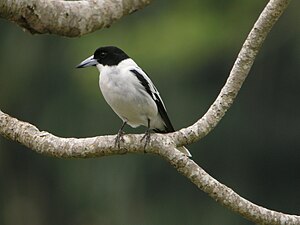Black-backed crow's shrike
| Black-backed crow's shrike | ||||||||||||
|---|---|---|---|---|---|---|---|---|---|---|---|---|

Black-backed crow's shrike ( Cracticus mentalis ) |
||||||||||||
| Systematics | ||||||||||||
|
||||||||||||
| Scientific name | ||||||||||||
| Cracticus mentalis | ||||||||||||
| Salvadori & D'Albertis , 1876 |
The black back Crow Würger ( Cracticus mental ), and black back Crow Star called, is a bird from the genus of cracticinae ( Cracticus ). It occurs exclusively in the far north of Australia and in the south of New Guinea. In comparison to the very similar black-throated crow's shrike , this species has not been well researched.
The IUCN classifies the stock situation of this species as harmless ( least concern ). There are two subspecies.
features
Build and color
The black-backed crow's shrike reaches a body length of around 25 to 28 cm, of which 10 to 15 cm are on the tail. The beak is 35.4 to 40.3 mm long. The black-backed crow's shrike has a wing length of 136-150 mm and a wingspan of 42 centimeters on average. The weight is between 74 and 110 g. There is no gender dimorphism .
Adult birds
The head and neck of the adult birds are black. The upper chin is black, the rest of the chin and the throat are white. The rest of the underside of the body is white. A wide white band runs in the nape of the neck, separated by a black patch in the middle of the back of the neck. This spot connects the black head plumage with the likewise black coat, back and the black wing covers. On the lower back, the black plumage turns gray and then the white of the upper tail-coverts. The tail plumage is black on top with a wide white tip. On the underside, the black part of the tail plumage is almost completely covered by the white under-tail covers and only the white tips of the tail feathers are visible.
The beak is pale blue-gray with a black tip. The iris is dark reddish brown. The legs and feet are dark gray.
Fledglings
In juveniles, all parts of the body that are plumed black in adult birds are dark brown. The white parts of the body are interspersed with brownish lines and spots. Their beak is completely gray.
Subadults who are not yet sexually mature already have black areas for the most part, but these are somewhat more matt and are interspersed with brown tones.
Possible confusion
The black-backed crow shrike can be easily distinguished from other crow shrike due to its size, its black chin and the otherwise white throat. The black-throated crow's shrike , which is similar to the black-backed crow's shrike, shares its range with this species only on the Cape York Peninsula . The black-throated crow's shrike not only has a black chin, but also a black throat and front chest. The gray-backed crow shrike has a predominantly gray body plumage, but does not occur in the distribution area of the black-backed crow shrike, but is native to Australia south of the Cape York Peninsula.
Distribution area and habitat
The black-backed crow's shrike occurs on the Australian Cape York Peninsula and in southern New Guinea. In New Guinea, the black-backed crow's shrike inhabits an area that extends from the Merauke River to the Balimo district. Another distribution area can be found in the south of the Central Province . The migration or migration behavior of the black-backed crow's shrike has not yet been conclusively investigated. Presumably it is a resident bird in the entire distribution area .
The habitat of the black-backed crow's shrike are light tropical forests. In the Australian village of Laura , the black-backed crow's shrike can often be seen in the interior of the village.
Way of life
The way of life of the black-backed crow's shrike has so far only been examined superficially. Their diet consists of invertebrates as well as small vertebrates. They also eat seeds as well. In their foraging forests they move slowly on the branches of the trees and occasionally come into the undergrowth. They also lie in wait for prey from stand guard.
Black-backed crow shrike are monogamous birds that occupy a territory as a pair all year round. The breeding season is unknown, in Australia nests with eggs were found in October and December. Eggs were found in New Guinea from August to late December. The nest is built in the fork of a tree. The clutch size is two to four eggs, but mostly three eggs are laid by the female. It is believed that only the female builds the nest and incubates the eggs. However, both parent birds are involved in feeding the young birds.
literature
- PJ Higgins, JM Peter and SJ Cowling: Handbook of Australian, New Zealand & Antarctic Birds: Volume 7 Boatbill to Starlings, Part A: Boatbill to Larks . Oxford University Press, Melbourne 2006, ISBN 978-0-195-55884-5 .
Web links
- Videos, photos and sound recordings of Cracticus mentalis in the Internet Bird Collection
Individual evidence
- ↑ a b black-backed-butcherbird-cracticus-mentalis Handbook of the Birds of the World zu Schwarzkehl-Krähenwürger , accessed on May 8, 2017
- ^ A b Higgins, Peter & Cowling: Handbook of Australian, New Zealand & Antarctic Birds: Volume 7 Boatbill to Starlings, Part A: Boatbill to Larks . P. 515.
- ^ Higgins, Peter & Cowling: Handbook of Australian, New Zealand & Antarctic Birds: Volume 7 Boatbill to Starlings, Part A: Boatbill to Larks . P. 511.
- ↑ a b c d Higgins, Peter & Cowling: Handbook of Australian, New Zealand & Antarctic Birds: Volume 7 Boatbill to Starlings, Part A: Boatbill to Larks . P. 512.
- ^ Higgins, Peter & Cowling: Handbook of Australian, New Zealand & Antarctic Birds: Volume 7 Boatbill to Starlings, Part A: Boatbill to Larks . P. 513.